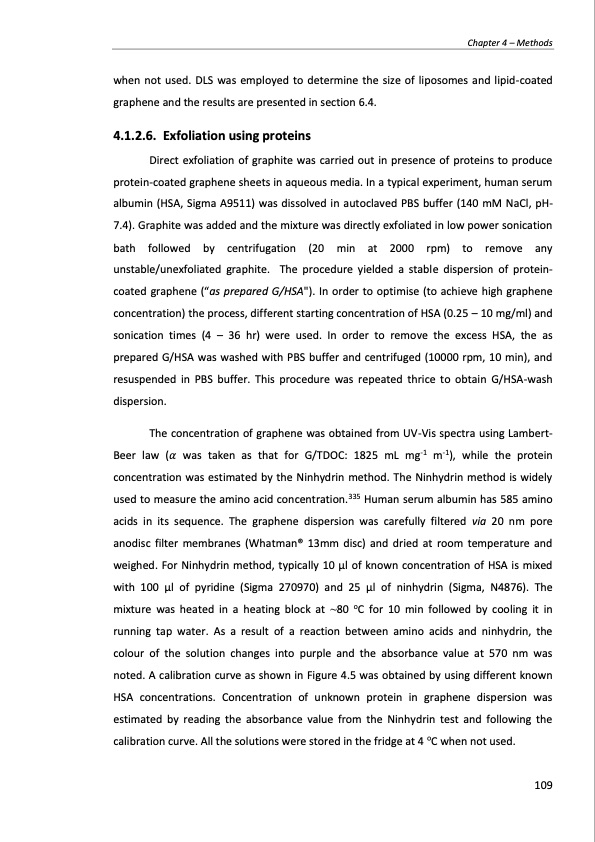PDF Publication Title:
Text from PDF Page: 109
when not used. DLS was employed to determine the size of liposomes and lipid-coated graphene and the results are presented in section 6.4. 4.1.2.6. Exfoliation using proteins Direct exfoliation of graphite was carried out in presence of proteins to produce protein-coated graphene sheets in aqueous media. In a typical experiment, human serum albumin (HSA, Sigma A9511) was dissolved in autoclaved PBS buffer (140 mM NaCl, pH- 7.4). Graphite was added and the mixture was directly exfoliated in low power sonication bath followed by centrifugation (20 min at 2000 rpm) to remove any unstable/unexfoliated graphite. The procedure yielded a stable dispersion of protein- coated graphene (“as prepared G/HSA"). In order to optimise (to achieve high graphene concentration) the process, different starting concentration of HSA (0.25 – 10 mg/ml) and sonication times (4 – 36 hr) were used. In order to remove the excess HSA, the as prepared G/HSA was washed with PBS buffer and centrifuged (10000 rpm, 10 min), and resuspended in PBS buffer. This procedure was repeated thrice to obtain G/HSA-wash dispersion. The concentration of graphene was obtained from UV-Vis spectra using Lambert- Beer law (𝛼 was taken as that for G/TDOC: 1825 mL mg-1 m-1), while the protein concentration was estimated by the Ninhydrin method. The Ninhydrin method is widely used to measure the amino acid concentration.335 Human serum albumin has 585 amino acids in its sequence. The graphene dispersion was carefully filtered via 20 nm pore anodisc filter membranes (Whatman® 13mm disc) and dried at room temperature and weighed. For Ninhydrin method, typically 10 μl of known concentration of HSA is mixed with 100 μl of pyridine (Sigma 270970) and 25 μl of ninhydrin (Sigma, N4876). The mixture was heated in a heating block at ~80 oC for 10 min followed by cooling it in running tap water. As a result of a reaction between amino acids and ninhydrin, the colour of the solution changes into purple and the absorbance value at 570 nm was noted. A calibration curve as shown in Figure 4.5 was obtained by using different known HSA concentrations. Concentration of unknown protein in graphene dispersion was estimated by reading the absorbance value from the Ninhydrin test and following the calibration curve. All the solutions were stored in the fridge at 4 oC when not used. Chapter 4 – Methods 109PDF Image | PRODUCTION AND APPLICATIONS OF GRAPHENE AND ITS COMPOSITES

PDF Search Title:
PRODUCTION AND APPLICATIONS OF GRAPHENE AND ITS COMPOSITESOriginal File Name Searched:
graphene-production-applications.PDFDIY PDF Search: Google It | Yahoo | Bing
Salgenx Redox Flow Battery Technology: Power up your energy storage game with Salgenx Salt Water Battery. With its advanced technology, the flow battery provides reliable, scalable, and sustainable energy storage for utility-scale projects. Upgrade to a Salgenx flow battery today and take control of your energy future.
CONTACT TEL: 608-238-6001 Email: greg@infinityturbine.com (Standard Web Page)